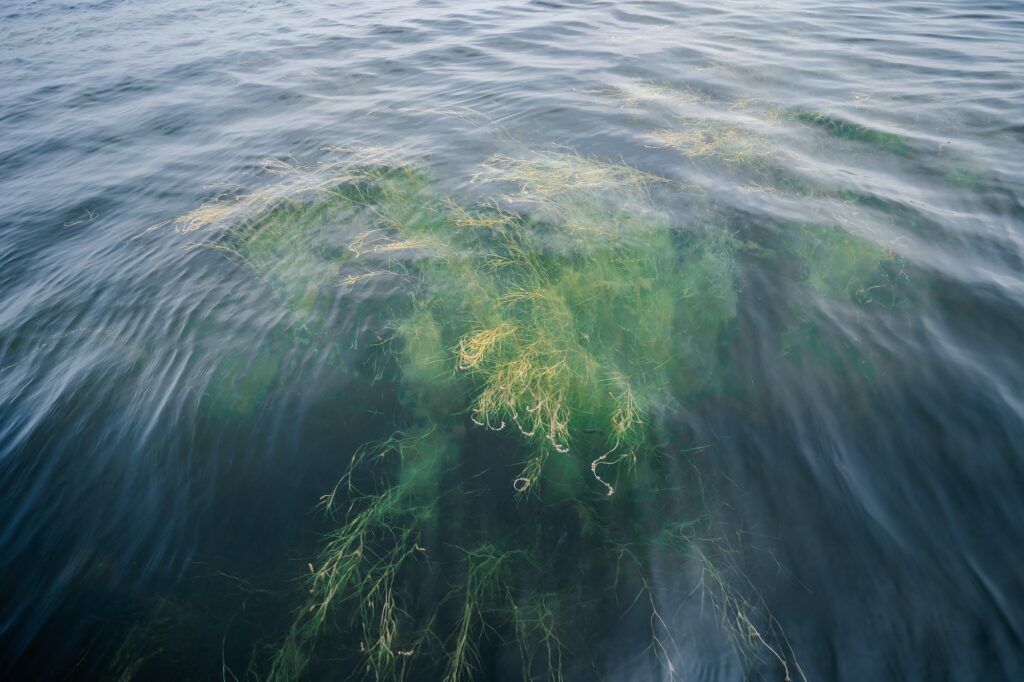As a pond owner, I know how frustrating it can be to deal with algae blooms. Not only do they make your pond look dirty and unappealing, but they can also be harmful to your aquatic plants and animals.
If you are struggling with algae in your pond, then you are not alone. In this blog post, I will share some tried and true methods to get rid of algae in a pond and preventing future outbreaks.
Step 1: Identify the type of algae

To successfully address an algae issue in your pond, you must first determine the specific type of algae present. Various kinds of algae exist, such as green algae, blue-green algae, and blanket weed. Each of these algae species necessitates a distinct treatment approach. Therefore, accurately identifying the type of algae present is critical for effective treatment.
Green algae are the most typical form of algae found in ponds. They are usually attached to surfaces, such as rocks or the pond’s sides, and may make the water appear green or murky. Green algae can be treated using a variety of methods, including chemical treatments, manual removal, and ultraviolet light.
Blue-green algae, also known as cyanobacteria, are a type of bacteria that can cause a variety of health problems in humans and animals. Blue-green algae blooms can produce toxins that can cause skin irritation, respiratory problems, and other health concerns. If blue-green algae is present, it is critical to take prompt action to avoid any harm to the environment.
Blanket weed, often known as filamentous algae, appears as long, stringy strands in the water. It can spread quickly and impede oxygen flow in the pond, causing harm to fish and other aquatic life. Blanket weed can be managed using a range of techniques, including manual removal, chemical treatments, and the use of barley straw.
Step 2: Determine the cause of the algae
There are several factors that can contribute to algae blooms in ponds, including excess nutrients, sunlight, and poor water circulation. In order to effectively treat your algae problem, you need to identify the root cause and address it.
For example, if excess nutrients (such as phosphates and nitrates) are causing the algae blooms, you may need to reduce the amount of fertilizer you are using or consider adding a nutrient-reducing product to your pond.
If sunlight is the problem, you may need to plant trees or install shading structures to reduce the amount of sunlight that reaches your pond.
And if poor water circulation is the issue, you may need to add a water fountain or aerator to improve circulation.
Step 3: Use chemical treatments
If you have identified the cause of your algae problem and taken steps to address it, but the algae persist, you may need to use a chemical treatment to kill the algae. There are several different types of chemical treatments available, including algaecides, herbicides, and copper sulfate.
- Controls many types of algae such as filamentous, chara, planktonic and swimmers itch for a beautiful and safe pond all year long
- When used as directed, Crystal Plex is 100 percent safe for humans, fish, livestock, pets, birds, swimming and irrigation
- Not for use in Koi, Goldfish, or Trout ponds
- Treat only a third to half of your pond at a time
- One gallon treats 1 surface acre 1-3 ft d
Prices pulled from the Amazon Product Advertising API on:
Product prices and availability are accurate as of the date/time indicated and are subject to change. Any price and availability information displayed on [relevant Amazon Site(s), as applicable] at the time of purchase will apply to the purchase of this product.
It is important to carefully follow the instructions on the product label and use caution when applying chemical treatments. Some treatments can be harmful to aquatic life, so it is a good idea to remove any fish or other animals from the pond before applying the treatment.
Step 4: Use physical removal methods
In addition to chemical treatments, you can also use physical removal methods to get rid of algae in your pond. Some options include:
Skimming
Skimming is a simple and inexpensive method that can be done manually with a net or with the use of mechanical skimmers. If done regularly, it can help prevent excessive algae growth and keep the pond clean and clear. Skimming can be particularly effective for small ponds or those with shallow areas.
To skim the algae from the pond, you need to gently drag the net or skimmer across the surface of the water, collecting as much of the algae as possible. It is important to avoid disturbing the water too much to prevent the algae from spreading and multiplying. The collected algae can be disposed of by composting or burying it away from the pond.
While skimming can be an effective method for algae control, it may not be sufficient for larger ponds or those with deep areas. In such cases, other methods like chemical treatments or aeration may be required to control algae growth. It is important to note that excessive use of chemical treatments can harm aquatic life and should be used with caution.
Vacuuming
In addition to skimming, vacuuming can also be an effective method for removing algae and other debris from the bottom of a pond. A pond vacuum is a specialized tool that uses suction to remove debris from the bottom of the pond. This method is particularly useful for larger ponds or those with deep areas where skimming may not be sufficient.
To use a pond vacuum, you first need to connect the hose to the vacuum and then connect the other end to a pump or filter system. Once the vacuum is set up, you can place the suction head at the bottom of the pond and turn on the pump or filter system to begin suctioning up the debris.
One advantage of using a pond vacuum is that it can remove debris that has settled at the bottom of the pond, including dead leaves, twigs, and other organic matter. This can help reduce the amount of nutrients in the pond and prevent excessive algae growth.
However, it is important to be cautious when using a pond vacuum, as it can also remove beneficial bacteria and other organisms that live at the bottom of the pond. It is important to use the vacuum sparingly and not disturb the sediment too much.
Manual removal: If the algae are concentrated in a specific area, you can try manually removing it with your hands or a rake.
Step 5: Implement preventative measures
Once you have gotten rid of the algae in your pond, it is important to take steps to prevent future outbreaks. Some things you can do include:
- Maintain proper pond care: This includes regularly testing and adjusting the pH and chlorine levels of the water, removing debris and excess nutrients, and properly maintaining your filtration system.
- Limit sunlight: As mentioned earlier, sunlight can contribute to algae blooms. Consider planting trees or installing shading structures to reduce the amount of sunlight that reaches your pond.
- Add aquatic plants: Aquatic plants help to absorb excess nutrients and oxygenate the water, which can help prevent algae blooms.
By following these steps, you can effectively get rid of algae in your pond and keep it looking clean and clear for years to come.



